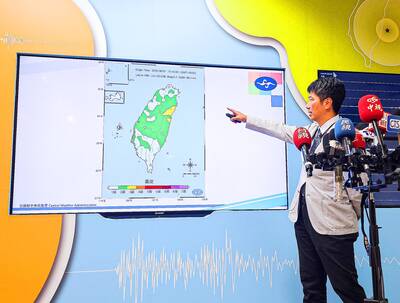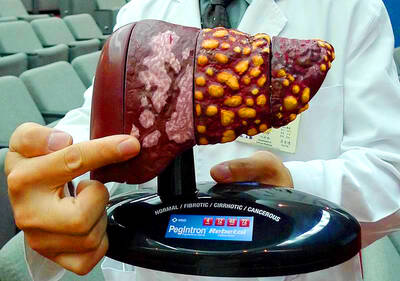Half a million people ride Taiwan’s trains every day to go to work or for sightseeing tours, but few are aware that the railway is in the red.
For most people, the 121-year-old railway system is part of the landscape and appears to be operating smoothly. But the railway’s operator, the Taiwan Railway Administration (TRA), knows otherwise.
The state-owned railway’s annual deficit has risen to NT$10 billion (US$313 million) over the past decade.
The deficit is caused by a loss of passengers and rising expenses, including paying pensions to 14,000 retirees and the salaries of 13,000 employees.
Over the years, the railway has faced growing competition, including the opening of the Sun Yat-sen Freeway in 1978, the launch of long distance bus companies, the arrival of domestic airlines and the addition of the high-speed rail last year.
Of all these, the 345km-long high-speed rail, built by a private consortium last year, poses the biggest challenge to the railway.
“Our west line has been losing passengers since the launch of the high-speed rail in March 2007. In 2007, our revenues fell by 10 percent year-on-year and the loss will increase in 2008,” TRA Deputy Director Chang Ying-hui (張應輝) said.
“We are suffering a 13 percent revenue loss on long-distance service and 5 percent revenue loss on mid-distance service, but there is a 1 percent increase in revenues on short-distance service,” he said.
The railway has taken several measures to lure passengers back but have not cut ticket prices, he said.
The initiatives include package tours, leasing carriages to travel agencies for sightseeing trips and allowing companies to charter entire trains.
“In August, we launched the ‘cruise train,’ which … like a cruise liner, stops at various scenic spots along the railway line to allow tourists to see the sea, smell flowers, ride bikes or do shopping for half and hour or one hour. Then the train moves again,” Chang said.
This “cruise train” service, which is a day tour, has been well received and will become a daily service, though to different destinations, starting from this Sunday.
Many Taiwanese like to ride the slow-moving train because it is safe, comfortable and is one of the remaining links to the Japanese colonial period.
The government is helping the TRA boost business by launching overseas campaigns, especially targeting Japanese tourists, to promote train tours.
On a recent tour in the hills outside Taipei City, 290 Japanese tourists enjoyed a one-hour ride from Pingsi (平溪), a former mining town in Taipei County, to a waterfall.
“The six-car train was pulled by a 70-year-old steam locomotive, and the Japanese were excited to see this old locomotive still working,” said Ivy Wang of the Taiwan Tourism Bureau.
Steven Kaiser, an Australian train engineer working in Taiwan, said railways in most countries lose money and need state support to survive. Compared with other countries, he thought that the Taiwanese railway was doing quite well.
“Taiwan has done an excellent job in integrating the railway, high-speed rail and the mass rapid transit system to provide seamless transport to passengers,” he said.
“While the traditional railway cannot compete with high-speed rail on long-distance journeys, it can make up [for this] by improving its service between small towns where the high-speed rail does not reach,” he said.
“While the high-speed rail is useful for those in a hurry, many people still like to sit in a slow train, open the window and enjoy the view while the train chugs along Taiwan’s coast or lumbers into tunnels and rice fields,” he said.

The Taipei Summer Festival is to begin tomorrow at Dadaocheng Wharf (大稻埕), featuring four themed firework shows and five live music performances throughout the month, the Taipei Department of Information and Tourism said today. The festival in the city’s Datong District (大同) is to run until Aug. 30, holding firework displays on Wednesdays and the final Saturday of the event. The first show is scheduled for tomorrow, followed by Aug. 13, 20 and 30. To celebrate the 30th anniversary of Disney Pixar's movie Toy Story, the festival has partnered with Walt Disney Co (Taiwan) to host a special themed area on

Aftershocks from a magnitude 6.2 earthquake that struck off Yilan County at 3:45pm yesterday could reach a magnitude of 5 to 5.5, the Central Weather Administration (CWA) said. Seismological Center technical officer Chiu Chun-ta (邱俊達) told a news conference that the epicenter of the temblor was more than 100km from Taiwan. Although predicted to measure between magnitude 5 and 5.5, the aftershocks would reach an intensity of 1 on Taiwan’s 7-tier scale, which gauges the actual effect of an earthquake, he said. The earthquake lasted longer in Taipei because the city is in a basin, he said. The quake’s epicenter was about 128.9km east-southeast

BE CAREFUL: The virus rarely causes severe illness or death, but newborns, older people and those with medical conditions are at risk of more severe illness As more than 7,000 cases of chikungunya fever have been reported in China’s Guangdong Province this year, including 2,892 new cases last week, the Centers for Disease Control (CDC) yesterday said it is monitoring the situation and considering raising the travel notice level, which might be announced today. The CDC issued a level 1 travel notice, or “watch,” for Guangdong Province on July 22, citing an outbreak in Foshan, a manufacturing hub in the south of the province, that was reported early last month. Between July 27 and Saturday, the province reported 2,892 new cases of chikungunya, reaching a total of 7,716

STAY VIGILANT: People should reduce the risk of chronic liver inflammation by avoiding excessive alcohol consumption, smoking and eating pickled foods, the physician said A doctor last week urged people to look for five key warning signs of acute liver failure after popular producer-turned-entertainer Shen Yu-lin (沈玉琳) was reportedly admitted to an intensive care unit for fulminant hepatitis. Fulminant hepatitis is the rapid and massive death of liver cells, impairing the organ’s detoxification, metabolic, protein synthesis and bile production functions, which if left untreated has a mortality rate as high as 80 percent, according to the Web site of Advancing Clinical Treatment of Liver Disease, an international organization focused on liver disease prevention and treatment. People with hepatitis B or C are at higher risk of